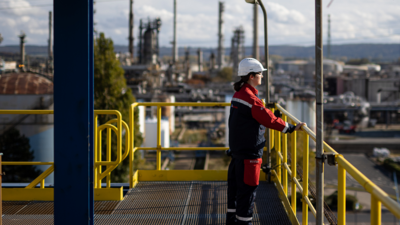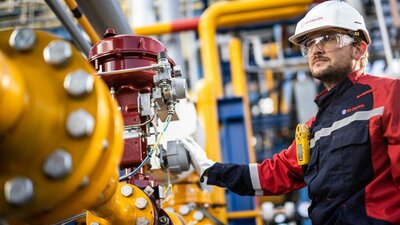Cracking ammonia to unlock the full potential of hydrogen
Published on December 11, 2024
2 minutes

Hydrogen plays a key role in the energy transition. But how can it be produced with a minimal carbon footprint? Air Liquide's new ammonia cracking technology offers an efficient and low-carbon solution, achieving the highest possible conversion yield from ammonia to hydrogen, without direct CO₂ emissions. Watch the video for more details.
How does ammonia cracking work?
How can ammonia be converted into hydrogen? To understand the ammonia cracking process, let’s first recall that ammonia (NH₃) is a molecule composed of nitrogen (N₂) and hydrogen (H₂). The process starts with the Ammonia “cracker”: ammonia is introduced in gaseous form into a catalytic cracking furnace where it is heated to over 500°C. This operation transforms the ammonia into two other gases: hydrogen and nitrogen. These high-temperature gases are then cooled, purified, and hydrogen is separated, while the remaining nitrogen and hydrogen are added to other fuels to feed the burners.
What makes Air Liquide's ammonia cracking technology unique?
All depends on the use of a proprietary heat integration technology with next-generation reactor tubes, achieving the highest possible ammonia-to-hydrogen conversion yield without direct CO₂ emissions.
Why is this solution promising?
Because it offers several key advantages. Firstly, ammonia can be produced with a low carbon footprint in regions that benefit from abundant renewable energy resources. Additionally, the ammonia molecule has beneficial properties, enabling large-scale, long-distance transport around the world. Moreover, a global supply chain infrastructure already exists for its production, transport, and large-scale use.
To fully leverage these benefits, the ammonia cracking now needs to be deployed at scale. In March 2023, Air Liquide announced the construction of its first industrial-scale pilot unit at the Port of Antwerp in Belgium. In December 2024, Air Liquide was also awarded a grant of 110 million euros from the European Innovation Fund for its ENHANCE project in the port of Antwerp-Bruges, the first European industrial-scale project for the production and distribution of low-carbon and renewable hydrogen using ammonia as a feedstock. As part of the project, Air Liquide intends to build, own and operate a first-of-its-kind large scale renewable ammonia cracking plant and an innovative hydrogen liquefier.
Ammonia is therefore a valuable resource for developing hydrogen, a field in which Air Liquide, with over 60 years of experience, has built unique expertise across the value chain—from production to distribution, including storage.


